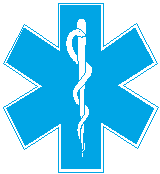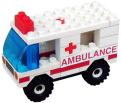


They happen. Because people do get sick and people do get injured, CALM is prepared 24 hours a day for medical emergencies.
Prior to the start of the Gathering
CALM crew contacts the local hospital(s) and EMS ambulance service. This is done to form a relationship, establish clear lines of communication and inform the local services what CALM is capable of and the level of service locally available.
Responding to reports of medical emergencies
The most common method of CALM being alerted to a possible medical emergency is a call for help over the radio. CALM uses FRS Channel 3 (in addition to a GRMS/repeater). Often, radio contact is made by concerned friends of someone who is perhaps too ill to walk to CALM. In those cases CALM volunteers will make a "hippy house call". When a true medical emergency is reported, CALM quickly activates "CMERT"- CALM Medical Emergency Reponse Team.
CMERT consists of CALM crew who are experienced in medical emergencies and are very familiar with the Gathering specific "protocol" for ambulance and ER interaction. Most often the people on the short list are EMTs, ER Nurses and WFR/FRs (Wilderness First Responders/First Responsers). CMERT volunteers will assess the nature of the medical emergency and determine if evac to a hospital is required. If evac is required, transport to the ER in the CALM Evac Vehicle, rendevouz of Evac Vehicle and ambulance or direct ambulance response where be determined where appropriate.

When an ambulance is necessary

Rendevouz between the Evac Vehicle and ambulance saves time- as much as an hour. More than once a loss of life has been prevented by this level of coordination. At times there are local regulations preventing the EMS ambulanlance from agreeing to a rendevouz, but rather CALM crew must specifically state, "We will meet you at Rendezvous Point 3."
When in communication with the 911 Center or ER, provide a detailed report as to the medical emergency, mechanism of injury, status of patient and the treatment currently being administered. Having someone experienced with "EMS Radio Reports" to give the report is very useful to responding services.
IMPORTANT: CMERT crew provides EMS treatment on the BLS level.
Non-emergency transfer to hospitals
In situations where an ambulance is not required, CALM will contact the ER via phone or radio to give a heads up and a detailed report, including reason for transfer, symptoms or injury, pertinant past medical history, treatment, etc.
These transfers are in such cases are fractures and other moderate injuries, illness beyond the scope of CALM, mental health emergencies, etc.
CALM Evac Vehicle
There is a well running, well maintained all-terrain vehicle at all times available for hospital transfer. There are two sets of keys for the vehicle given to two experienced drivers, in order to prevent delays in time. It can contain a Stokes Stretcher secured in, room for up to three CMERT clinicians and EMS equipment.
A driver and a CALM crew member accompany the patient to the hospital. The crew member will give a full report to ER staff at the hospital.
The Evac Vehicle has been identified by the placement of large red duct tape in the form of a Red Cross on the hood, rear and both sides. Additionally, "CALM EMS" is written on all sides. Here are pictures of the type of Evac Vehicle used in recent years.

